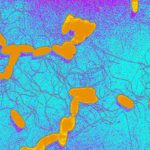Lien vers Pubmed [PMID] – 15750057
J. Clin. Microbiol. 2005 Mar;43(3):1037-44
In this study, we report an outbreak of Salmonella enterica serotype Livingstone resistant to extended-spectrum cephalosporins that occurred in a neonatal ward of the maternity department of Farhat Hached Hospital, Sousse, Tunisia, in 2002. A total of 16 isolates were recovered from 16 babies hospitalized in the ward during the period 1 to 16 July. All these babies developed diarrhea, and three of them developed septicemia. All the isolates demonstrated resistance to ceftriaxone and ceftazidime due to the production of an extended-spectrum beta-lactamase (ESBL). The isolates were also resistant to aminoglycosides (kanamycin, tobramycin, netilmicin, gentamicin, and amikacin) and sulfamethoxazole-trimethoprim. DNA profiles were determined by pulsed-field gel electrophoresis using the XbaI and SpeI endonucleases and by ribotyping with PstI digestion. They yielded the same patterns, showing that the outbreak was caused by a single clone. The ESBL was identified as CTX-M-27 by sequencing of PCR products and by isoelectric focusing. The ESBL resistance was transferred by a 40-kb conjugative plasmid. The mobile insertion sequence ISEcp1 was found to be located upstream of bla(CTX-M-27) in the same position as that known for a bla(CTX-M-14) sequence. A new gene named dfrA21, encoding resistance to trimethoprim and carried by a 90-kb plasmid, was characterized. The dfrA21 gene was inserted as a single resistance cassette in a class I integron. The babies were treated with colistin, and all except two recovered. The outbreak came to an end when appropriate actions were taken: patient isolation, hand washing, and disinfection of the ward.

